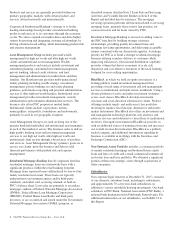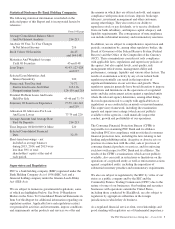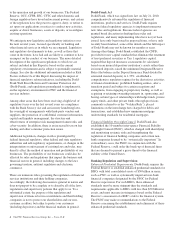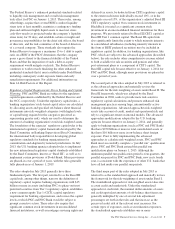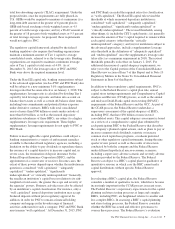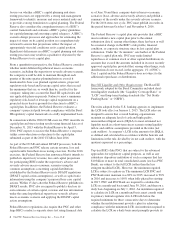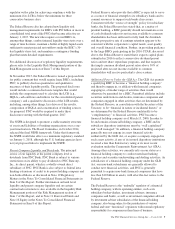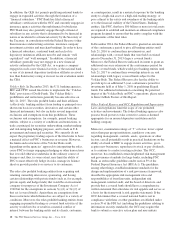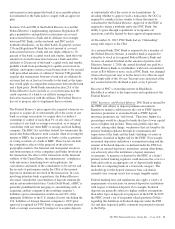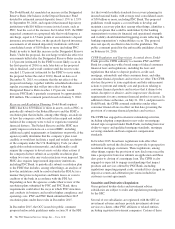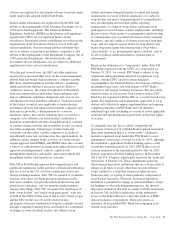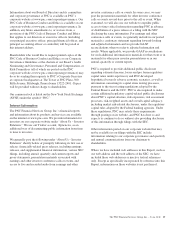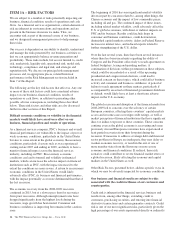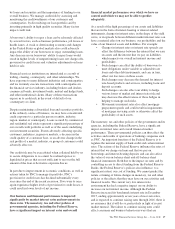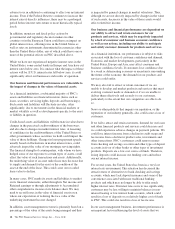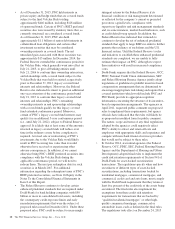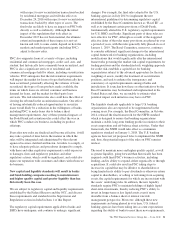PNC Bank 2015 Annual Report Download - page 30
Download and view the complete annual report
Please find page 30 of the 2015 PNC Bank annual report below. You can navigate through the pages in the report by either clicking on the pages listed below, or by using the keyword search tool below to find specific information within the annual report.
The Dodd-Frank Act mandated an increase in the Designated
Reserve Ratio (the balance in the Deposit Insurance Fund
divided by estimated insured deposits) from 1.15% to 1.35%
by September 30, 2020, and required that insured depository
institutions with $10 billion or more in total assets, such as
PNC, bear the cost of the increase. In October 2015, the FDIC
requested comment on a proposed rule that would impose a
surcharge, equal to 4.5 basis points of an institution’s deposit
insurance assessment base, on the quarterly deposit insurance
assessments of all insured depository institutions with total
consolidated assets of $10 billion or more (including PNC
Bank) in order to fund this increase in the Designated Reserve
Ratio. Under the proposal, the surcharge would take effect for
assessments billed after the Designated Reserve Ratio reaches
1.15 percent (estimated by the FDIC to most likely occur in
the first quarter of 2016) or such later date as the proposed
rule is finalized, and would continue until the reserve ratio
reached 1.35 percent (estimated by the FDIC to occur under
the proposal before the end of 2018). Based on data as of
December 31, 2015, we estimate that the net effect of the
proposed surcharge, together with the scheduled reduction of
regular assessments that will go into effect when the
Designated Reserve Ratio reaches 1.15 percent, would
increase PNC Bank’s quarterly assessment by approximately
$20 million. The comment period closed on January 5, 2016.
Recovery and Resolution Planning. Dodd-Frank requires
BHCs that have $50 billion or more in assets, such as PNC, to
periodically submit to the Federal Reserve and the FDIC a
resolution plan that includes, among other things, an analysis
of how the company could be resolved in a rapid and orderly
fashion if the company were to fail or experience material
financial distress. The Federal Reserve and the FDIC may
jointly impose restrictions on a covered BHC, including
additional capital requirements or limitations on growth, if the
agencies jointly determine that the company’s plan is not
credible or would not facilitate a rapid and orderly resolution
of the company under the U.S. Bankruptcy Code (or other
applicable resolution framework), and additionally could
require the company to divest assets or take other actions if
the company did not submit an acceptable resolution plan
within two years after any such restrictions were imposed. The
FDIC also requires large insured depository institutions,
including PNC Bank, to periodically submit a resolution plan
to the FDIC that includes, among other things, an analysis of
how the institution could be resolved under the FDI Act in a
manner that protects depositors and limits losses or costs to
creditors of the bank in accordance with the FDI Act.
Depending on how the agencies conduct their review of the
resolution plans submitted by PNC and PNC Bank, these
requirements could affect the ways in which PNC structures
and conducts its business and result in higher compliance and
operating costs. PNC and PNC Bank submitted their 2015
resolution plans under these rules in December 2015.
In December 2015, the OCC issued for public comment
proposed enforceable guidelines under section 39 of the FDI
Act that would establish standards for recovery planning for
insured national banks, with average total consolidated assets
of $50 billion or more, including PNC Bank. The proposed
guidelines would require a covered bank to develop and
maintain a recovery plan that, among other things, identifies a
range of options that could be undertaken by the banking
organization to restore its financial and operational strength
and viability should identified triggering events reflecting the
banking organization’s vulnerabilities occur. The proposal
does not specify an effective date for the guidelines. The
public comment period for the enforceable guidelines closed
on February 16, 2016.
CFPB Regulation and Supervision. As noted above, Dodd-
Frank gives the CFPB authority to examine PNC and PNC
Bank for compliance with a broad range of federal consumer
financial laws and regulations, including the laws and
regulations that relate to deposit products, credit card,
mortgage, automobile and other consumer loans, and other
consumer financial products and services we offer. The CFPB
also has the power to issue regulations and take enforcement
actions to prevent and remedy acts and practices relating to
consumer financial products and services that it deems to be
unfair, deceptive or abusive, and to impose new disclosure
requirements for any consumer financial product or service. In
addition to these authorities, on July 21, 2011, and pursuant to
Dodd-Frank, the CFPB assumed authorities under other
consumer financial laws in effect on that date governing the
provision of consumer financial products and services.
The CFPB has engaged in extensive rulemaking activities,
including adopting comprehensive new rules on mortgage
related topics required under Dodd-Frank, including borrower
ability-to-repay and qualified mortgage standards, mortgage
servicing standards and loan originator compensation
standards.
In October 2015, broad new regulations took effect that
substantially revised the disclosures we provide to prospective
residential mortgage customers. These regulations, among
other things, require the provision of new disclosures near the
time a prospective borrower submits an application and three
days prior to closing of a mortgage loan. The CFPB is also
engaged or expected to engage in rulemakings that impact
products and services offered by PNC Bank, including
regulations impacting prepaid cards, overdraft fees charged on
deposit accounts and arbitration provisions included in
customer account agreements.
Securities and Derivatives Regulation
Our registered broker-dealer and investment adviser
subsidiaries are subject to rules and regulations promulgated
by the SEC.
Several of our subsidiaries are registered with the SEC as
investment advisers and may provide investment advisory
services to clients, other PNC affiliates or related entities,
including registered investment companies. Certain of these
12 The PNC Financial Services Group, Inc. – Form 10-K


